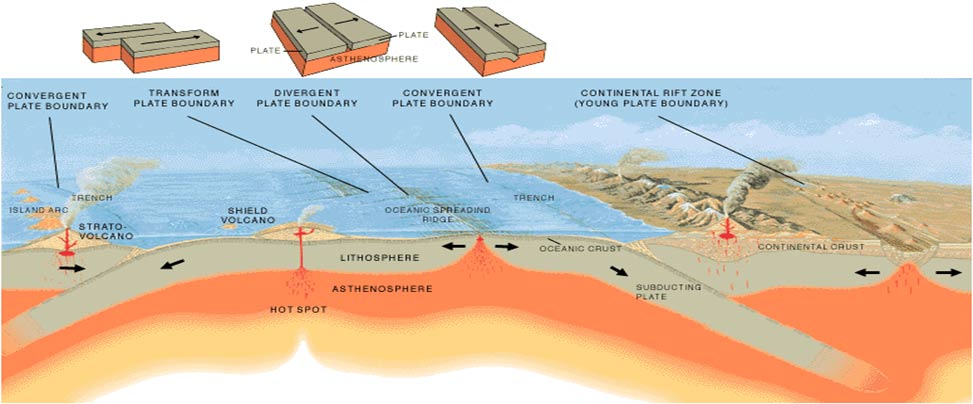Tectonic evolution of the Earth and its implications for life formation and long-term climate change
In a reconstruction of the evolution of the Earth over the past billion years, Merdith et al (2021) have generated a video in which continents collide and morph into supercontinents, break apart and then collide again into new formations, ending with the patterns of continents and oceans we have now. Heat from radioactive decay within the Earth causes convection cells in the Earth’s mantle that continually drive the plates and the continents riding on them, converging with each other and splitting them apart. The geological record, which is full of evidence of old plate boundaries and the past actions of plates, has been integrated into this first reconstruction of the evolution of the Earth over the past billion years. The red lines are subduction zones with teeth marks on the overriding plate (below which oceanic lithosphere is being subducted and removed from the Earth’s surface), and the blue lines are the oceanic spreading ridges where the mantle is upwelling and forming oceanic lithosphere on the Earth’s surface, offsetting the loss of oceanic crust at subduction zones, as shown schematically in Figure 1. Each second of the time lapse video in this link represents 25 million years.
https://cosmosmagazine.com/earth/earth-sciences/tectonic-timelapse/

This reconstruction, which is described by Fuge (2021) and illustrated in Figure 2, not only provides geoscientists with a much better understanding of the evolution of the Earth; it will also help biologists understand how complex life began on Earth. It is only in the last billion years of the Earth’s 4.5-billion-year history that life worked out how to form cells, combine them, and make complicated creatures. Although scientists know that many of the elements required by life – such as the phosphorous in our DNA – came from the deep Earth and must have been brought to the surface by tectonic processes at some time in the past, we need a framework for understanding how the Earth’s many complex, interrelated systems have evolved over time so that we can quantify and test long term models of the Earth’s climate and the evolution of life.
Remarkable changes have swept across the Earth over the past billion years. Starting around 720 million years ago, two massive ice ages engulfed the planet in glaciers from pole to equator in an event called Snowball Earth. When the Earth emerged from the ice, protozoa – the first true animals – evolved. By 635 million years ago, the first complex multicellular organisms were flourishing in warm and shallow seas, and then 500 million years ago life exploded with diversity, giving rise to the ancestors of all animals we know today.
Climate events like Snowball Earth are thought to be interrelated with both plate tectonics and the evolution of life in an intricate web of cause-and-effect. For example, large-scale weathering of mountain chains may have plunged the Earth into an ice age. Global glaciers would have ground down mountains and sent a flood of nutrients out to sea, which may have caused bacteria to bloom and churn out oxygen, changing the composition of the atmosphere into the one we are familiar with today – the atmosphere in which life as we know it evolved.
The tectonic timelapse described here obviously spans a vastly longer time interval than the changes in climate that have become increasingly apparent over the last several decades and are of concern today. However, it serves as a reminder that changes in climate that were practically unthinkable fifty years ago are now clearly evident. The same is true of the scientific revolution that occurred as notions of “continental drift,” first proposed by Alfred Wegener in 1912 and pursued by, among others, Professor Sam Carey at the University of Tasmania, were rejected out of hand for fifty years by established geoscience until eventually becoming universally accepted in the theory of Plate Tectonics in the 1970’s. Professor Carey would be proud that ten of the thirteen authors of the tectonic timelapse study by Merdith et al. (2021) work at Australian universities.
Merdith et al. (2021) includes researchers from France, Canada, China and Australia who integrated decades of geological data to reconstruct the planet’s tectonic evolution, then input it into the GPlates software developed by the EarthByte research group at the University of Sydney. The software is a GIS system for representing data related to positions on the Earth’s surface, but also has a time dimension that records where the plate boundaries were and how they evolved, and how continents collided and split apart.
Figure 2. Configuration of the plates and continents 410 million years ago (top) and 50 million years ago (bottom). Source: Merdith et al., 2021.
References
Fuge, Lauren (2021). Tectonic timelapse – This just in: one billion years of Earth’s history in 40 seconds. COSMOS Newsletter 4 February 2021. https://cosmosmagazine.com/earth/earth-sciences/tectonic-timelapse/
Merdith, Andrew S., Simon E. Williams, Alan S. Collins, Michael G. Tetley, Jacob A. Mulder, Morgan L. Blades, Alexander Young, Sheree E. Armistead, John Cannon, Sabin Zahirovic, R. Dietmar Müller, Extending full-plate tectonic models into deep time: Linking the Neoproterozoic and the Phanerozoic, Earth-Science Reviews, Volume 214, 2021, 103477, ISSN 0012-8252, https://doi.org/10.1016/j.earscirev.2020.103477.
About the author/s

Paul Somerville
Paul is Chief Geoscientist at Risk Frontiers. He has a PhD in Geophysics, and has 45 years experience as an engineering seismologist, including 15 years with Risk Frontiers. He has had first hand experience of damaging earthquakes in California, Japan, Taiwan and New Zealand. He works on the development of QuakeAUS and QuakeNZ.

